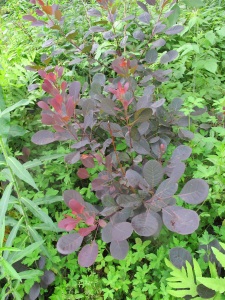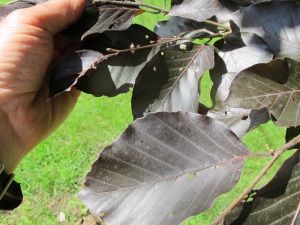Red-leafed Plants
When I bought my house in 1970 it had no landscaping. But I’ve lived in it ever since and have been working on the gardens all that time (except when I was off seeing the world and serving in the Peace Corps). The first tree I planted was a Japanese red maple (Acer palmatum). I grew up in Connecticut and my parents had a big one in the yard that I loved. It was, I’d estimate, 40 feet tall and wide, a great broad climbing tree with maroon-colored leaves. So around 1971 I dug up a seedling and moved it north.
That little maple is still alive, but never has gotten close to the size of my parents’ tree. It’s just 10 feet tall with a 12-foot spread. Why so small? It’s growing too far north. It survives, but is stunted by the climate. Not only that, as a nearby tree has spread and shaded it, the leaves are no longer the deep purple they once were; now they have a greenish tinge. Oh well. I later got another and put it in a sunnier location and it has leaves that are a deeper reddish color.
Like many gardeners, I like plants with deep red or purplish leaves. They provide a contrast to all the greenery in our landscape. There are some nice trees and shrubs to pick from –including one very popular one that is now on the prohibited invasive species list in most states, the Norway maple ‘Crimson King’. That one is a “sport”, or genetic mutation. All Norway maples (Acer platanoides), including the green ones, are invasive.
The original Crimson King has been cloned and sold for decades. Eventually environmentalists figured out that seedlings from them having been taking over our woods, outcompeting our native maples and other plants. The seedlings generally are green-leaved, so many gardeners think they are sugar maples. Snap off a leaf and look at the stem. If it oozes white sap, it’s a Norway maple.
Norway maples have amazing root systems that steal the moisture and nutrition from the soil for long distances, depriving other plants. So if you have a nice big maple with nearly black leaves, know that it is a thug – and consider replacing it even though no plant police will come after you.
I have a fast-growing shrub with handsome dark purple leaves that would exceed the size of my Japanese red maple if I didn’t give it a yearly “haircut”. It’s a common ninebark (Physocarpus opulifolius), a variety called ‘Diablo’. This is a shrub native to the United States though I have never seen one in the woods. Diablo was introduced in 2000 and has become very popular, mainly for its leaf color which is good from spring to fall, but also for its nice 2-inch pinkish blossoms in June.
According to me, common ninebark grows too fast. Mine can grow 3 feet in a summer, and I really don’t want it to. I prefer shrubs like fothergilla or daphne that rarely need pruning. Diablo can quickly get to 10 feet tall and wide, and its root system is substantial. Hardy to Zone 2 (minus 50 degrees), nothing is going to kill it. It prefers full sun, but will tolerate anything and survive in bad soil, acid or alkaline. Planted in a row, it could be a good hedge.
Purple smoke bush (Cottinus cogyria) is a purple-leafed plant I’ve have had since 1999. Mine often dies back to the ground after a cold winter, but the roots send up new shoots no matter what. I often cut back all shoots in early spring, which stimulates it to produce new shoots and keep it a tidy shrub instead of a gangly winter-bitten one. These often grow 3 to 4 feet in a season. Doing this means it never blooms, but the foliage is a splendid deep wine color, so I don’t mind. In warmer climes it can grow to be a small tree or large shrub with large diaphanous blossoms – the smoke – that is quite glorious.
I also have a crabapple tree with dark maroon leaves. I called E.C. Brown Nursery in Thetford, VT where I bought it some 15 years ago to see if they could help me identify the cultivar. After some discussion and a look on the web, I decided it was ‘Ruby Tears.’ Mine was trained into a spiral, and has branches that weep or droop down. I’ve kept it small – it is only 8 feet tall and wide. But it has nice dark leaves that are quite striking in the spring, getting a bit greener as the season goes on. It is loaded with pink blossoms every year.
Other dark-leafed crabapples include ‘Prairie Fire’, which I have seen as a full-sized tree, or if grown on dwarfing rootstock, as a small one. All apples are grafted onto rootstocks because the seeds do not breed true. The rootstock determines the ultimate size from dwarf to full-sized. Prairie Fire has greenish-red leaves by mid-summer, getting greener as time goes on.
European beech (Fagus sylvatica) has some very nice purple-to-black-leafed cultivars, and although there is one growing in my town, I have never tried growing it. The leaves are really quite black at this time of year, and the one I have observed is 20 years old or more, about 18 feet tall and 12 feet wide. It is rated as a marginally hardy in Zone 4, but this one has survived winters approaching 30 below zero.
Planting a tree is an investment in money, time and space. Research your choices well, plant them where they will do well, and your grandchildren will enjoy them in the future.
Henry can be reached at his web site, www.Gardening-Guy.com. He is the author of 5 books and is a UNH Master Gardener.





